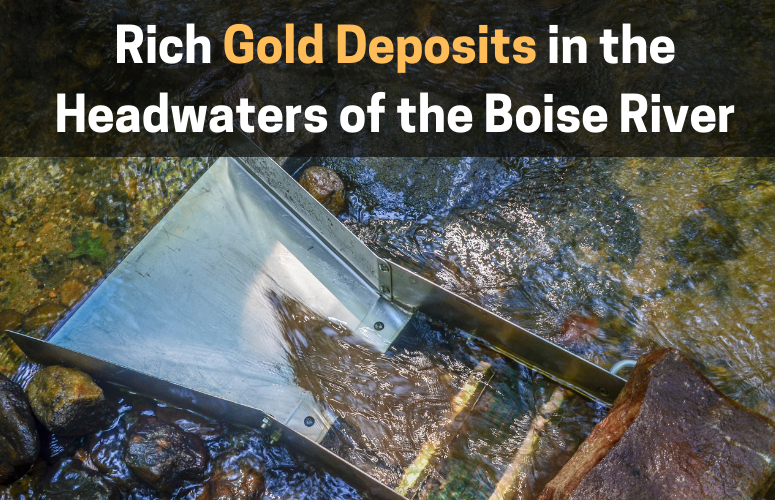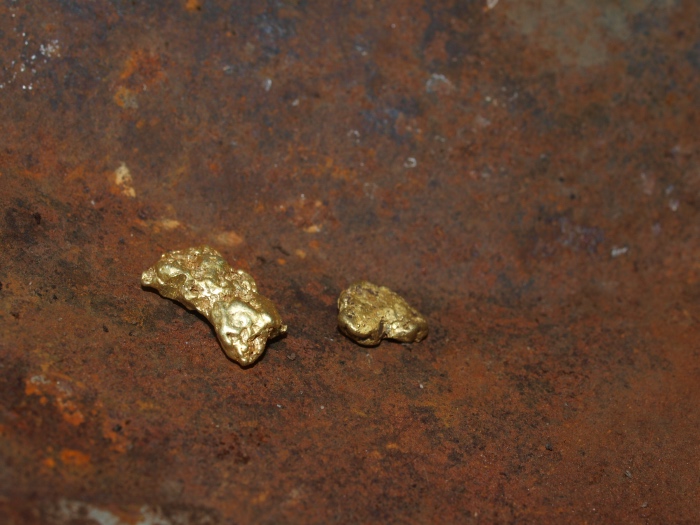
Prospectors in southern Idaho are well acquainted with the geological richness of mountains surrounding Boise. After all, Idaho is the Gem State, well known for its natural beauty and bountiful mineral richness. A tributary of the Snake River, the Boise River is 102 miles long and its watershed covers a whopping 4,100 square miles of various terrain and diverse ecosystems. Today we explore the portions of the river where the much coveted golden mineral can be found, and how this has impacted its surroundings throughout the years.
The Boise River rises in three separate forks in the Sawtooth Range and drains the minerally rich and mountainous country. Both gold and silver can be found here. Much of the river has been placer-mined downstream of Atlanta, one of the mining towns that was established due to prospecting activity. Today, visitors can still see the mining towns that cropped up along this portion of the river during the late 1800s.
The Atlanta Strike
It was in 1864 when activity from the initial discoveries on the Yuba River extended towards the Middle Fork of the Boise, and a bigger gold rush quickly began. Word of John Simmons’ discovery of a lode that contained both gold and silver soon spread, and thousands of miners flocked to the area.
Due to the remote location of the lode, activity was slow to pick up in the early years, but by the 1870s various investors from all around the world had operations onsite. British and Canadian firms were operating in the richest claims, and capital poured in to fund mineral activity. Gold was the predominant mineral recovered from here due to Atlanta silver being refractory in nature. In 1874, a richer lode extending the initial Atlanta quartz outcrop was discovered, called the Buffalo lode, and the mineral industry continued its positive trajectory.
The discoveries of the Minerva, Tahoma, Last Chance and Big lodes occurred subsequent to these finds and development flourished. Gold production reached its height between the years of 1877 and 1884, but due to a lack of major infrastructure and road construction posing significant challenges, activity tapered out in the early 1900s.
Despite the significantly smaller population in Atlanta, one can still mine for gold there today, with various private claims that still operate as a testament to the continued interest. Apart from the minerals which await diligent prospectors, Atlanta is home to the beautiful scenic views well worth a visit. One can rest in the shadow of the Sawtooth Mountain Range and trek through the lush Boise National Forest, or even visit restored homes and mining cabins in the Atlanta Historic District. In the summer, Atlanta is most commonly accessed by taking the road along the Middle Fork, or from the south through Anderson Ranch Reservoir, at Pine and Featherville.

South Fork Boise River
The latter two towns are also mining towns worth looking into. Featherville is located towards the South Fork of the Boise River. This town was initially established as a stop for miners heading over to the nearby Rocky Bar camp, and was first called Junction Bar as a result. However, due to the rich finds of placer deposits near the town, it soon grew into its own well-established community. The most significant recorded activity took place in the 1920s, with a dredging operation recovering over 32,000 ounces of gold.
Pine is also located on the South Fork of the Boise River, a few miles south of Featherville. In the 1860s, placer gold was also discovered in this area that had been the primary settlement of the Pine Grove mining district. Little is known about its early history, although it was noted to have been inundated by the waters of the Anderson Ranch Reservoir in 1950. The Pine settlement then moved to the area where the river flows into the reservoir, although today it is much more of a seasonal town.
Other areas near Featherville where gold discoveries have been made are found along Bear Creek, at the settlement of Rocky Bar. Like the other mining towns that dot this area, Rocky Bar is now a ghost town despite having once boasted a bustling population of 2,500 and was Elmore County seat back in the day.
A Recent Trip to Idaho’s Yankee Fork Gold Dredge
Gold throughout the River
The lure of finding that precious golden nugget at the bottom of your pan is certainly a powerful draw. However, there is also a certain charm in visiting the mining ghost towns that dot the Boise River. Strolling through the paths towards the old mines and imagining the prospectors of old is a treasure of its own kind.
Well downstream from the lode mining activity, placer deposits can be found throughout the Boise River in nearly all of the forks. This is a highly mineralized region, and there are likely thousands of minor, undiscovered sources of gold that continuously feed gold into the river system.
Claims span for many miles along the headwaters of the North, Middle and South Forks of the Boise River. The gold is generally fine textured rather than big chunky gold nuggets, but it’s there in considerable quantity. This was once a popular suction dredging area, although current regulations have created challenges in recent years.
Surprisingly to many, gold can be panned from the gravels as far downstream as Boise. Additional there are hundreds of minor tributaries from the southern flanks of the Sawtooth Mountains all the way to Boise that will turn up small quantities of gold if you diligently pan the gravels. There’s more gold in this country than many people realize.
